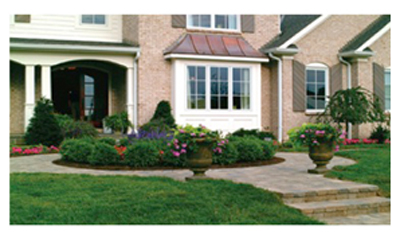What Is Colorcast & Why Is It Important?
I have been talking about exterior colors and materials for so long that it is easy to forget that not everyone knows what some of the terms specifically mean. Recently I was talking to a roofing pro and he asked me to explain "colorcast" since he wasn't completely sure what I meant when I used that phrase.

Great question! I'm glad he asked because as the old saying goes, "If you are asking the question, then there are many more people wondering but not speaking up." Thanks for asking!
Here is what I mean when I say "colorcast" and why I don't say just "color" instead.
Colorcast is a term I use when talking about stone, brick, roofing, or other hardscape materials. Generally these are not a solid color, but a mix of colors. To describe these materials as a solid color would not do them justice since the beauty is in the variations of colors. Instead, I found that the term "colorcast" was a better way to describe the common color in a blend of these materials.
Colorcast is a term that has roots in photography and describes an overall tint on a photographic image caused by sunlight or incandescent light. If you image an entire image looking slightly yellowish you will get the idea.
Now think of this same idea applied to stonework, bricks or your roofing material. The color cast is the tint of a particular color that looks like it has been washed over the blend. All of the colors throughout are not the same but they have a common tinge of a color that is common to the overall blend.
In photography, colorcast is something that needs to be corrected. In exterior materials it is something that needs to be respected.

Brick blends with the colorcast called out above each set
Identifying and repeating the colors or color cast from one fixed feature to the next, begins to visually tie the exterior color scheme together. When all of the permanent elements from the roof down harmonize, it sets the stage for a bespoke exterior color scheme by opening up options for the siding color.

Brick blends matched to DaVinci Roofscapes synthetic slate or shake tiles
If the fixed features are gray, or have a gray color cast, just about any color family will work. Brown or warmer color casts often work well with siding colors that are also warm. This doesn’t just mean tan or brown, as any color with golden or reddish undertones, can work.

Here you can see how blends of stone match to the DaVinci Roofscapes synthetic slate or
shake tiles in the same way that the brick did even through there seem to be more variations
of color. What makes these combinations works so well is the common colorcast.
When the fixed features do not have the same color or colorcast, it become more of a challenge to find siding, trim and accent colors that work with the fixed features. The other colors will have to visually tie the two mis-matched fixed features together.
It is always possible to find a color solution, but bringing two strong elements together that are not working together into a harmonious scheme can be a challenge even for the most skilled professional.
I hope that gives you a better understanding of colorcast and why it is important to identify and/or match the colorcast of the materials for the fixed features of a home.
